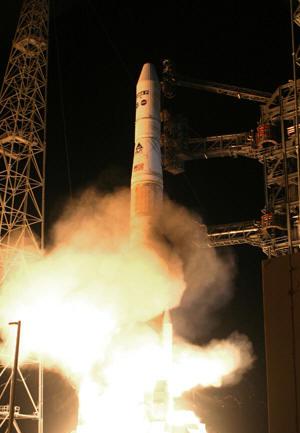 |
|
|
|
|
|
|||
|
By Daniel Baxter |
||||
 |
March 9, 2010 - On Thursday marked a significant milestone in Federal Aviation Administration (FAA) efforts overseeing the safety of the nation’s commercial space transportation industry with the 201st FAA licensed commercial rocket launch. The vehicle carried into orbit an environmental satellite to improve weather forecasting and help monitor environmental events. FAA’s Office of Commercial Space Transportation safety inspectors were present to monitor operations of the Delta IV booster. “With, the retirement this year of NASA's Space Shuttle, the nation will now look to the commercial space industry to take on added responsibilities, including commercial human space flights and replenishing equipment and technologies at the International Space Station,” said FAA Associate Administrator for Commercial Space Transportation George Nield. “Americans can feel confident that FAA’s Office of Commercial Space Transportation will be on the job monitoring and overseeing the safety of these new and exciting activities,” he added.
“Our geostationary
satellites are the nation’s weather sentinels in the sky,” said Jane
Lubchenco, Ph.D., under secretary of commerce for oceans and atmosphere
and NOAA administrator. “With more than 35 million Americans living in
hurricane prone areas and more than 1,000 tornadoes touching down in the |
|||
|
GOES-P is the final spacecraft in the latest series of NOAA
geostationary satellites, capturing higher resolution images of weather
patterns and atmospheric measurements than those provided by earlier
satellites. The higher resolution allows forecasters to pinpoint the
location of severe weather with greater accuracy. GOES-P also provides better data for space and solar weather thanks to its Solar X-Ray Imager. The SXI imager is to space weather forecasting what satellite images are to hurricane forecasting. This data will improve forecasts and warnings for solar disturbances, protecting billions of dollars of commercial and government assets in space and on the ground. This vital information will also reduce the effect of power surges for the satellite-based electronics and communications industry. |
||||
|
NOAA has two
operational GOES satellites hovering 22,300 miles above the equator –
GOES-12, in the east, and GOES-11, in the west – each provide continuous
observations of environmental conditions of North, Central and South
America and surrounding oceans. GOES-13, currently in a storage orbit,
is being moved to replace GOES-12, which will be positioned to provide
coverage for
On March 14,
GOES-P will be placed in its final orbit and renamed GOES-15. Once it
reaches geostationary orbit, GOES-P will undergo a series of tests for
approximately six months before completing its “check-out” phase. After
check out, GOES-P will be placed into orbital storage and remain ready
for activation if one of the operational GOES fail. |
| ©AvStop
Online Magazine
Contact
Us
Return To News
|
|
